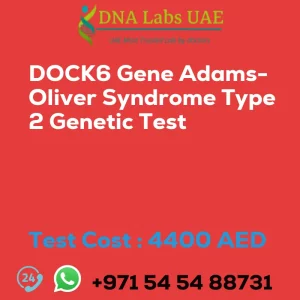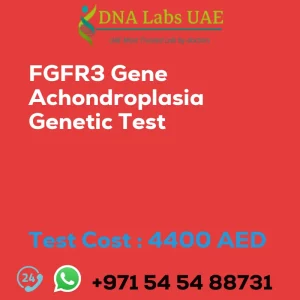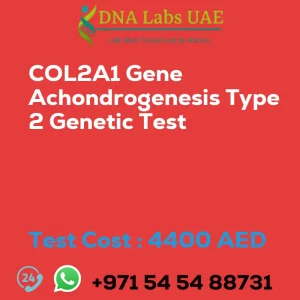EDAR Gene Ectodermal Dysplasia Hypohidrotic Autosomal Recessive Genetic Test
Welcome to DNA Labs UAE, a leading genetic lab offering comprehensive genetic testing services. In this blog, we will discuss the EDAR gene and its association with a condition called hypohidrotic ectodermal dysplasia (HED).
Test Details
The EDAR gene is associated with hypohidrotic ectodermal dysplasia, an autosomal recessive disorder. Our NGS (Next-Generation Sequencing) genetic testing can analyze the EDAR gene for any mutations or variations that may be present.
Symptoms and Diagnosis
Hypohidrotic ectodermal dysplasia affects the development of ectodermal tissues, including the skin, hair, teeth, and sweat glands. Individuals with HED may experience sparse or absent hair, abnormal teeth, and reduced ability to sweat. Other symptoms may include dry skin, heat intolerance, and respiratory problems.
To diagnose hypohidrotic ectodermal dysplasia, a clinical history of the patient is obtained, and a genetic counseling session is conducted to draw a pedigree chart of family members affected by the condition. The NGS genetic DNA test analyzes the EDAR gene to identify any variations or mutations responsible for the disorder.
Test Components and Price
The EDAR Gene Ectodermal Dysplasia Hypohidrotic Autosomal Recessive Genetic Test is priced at 4400.0 AED. The test requires a blood sample, extracted DNA, or one drop of blood on an FTA card.
Report Delivery and Method
The report for the EDAR Gene Ectodermal Dysplasia Hypohidrotic Autosomal Recessive Genetic Test is delivered within 3 to 4 weeks. The test is conducted using NGS technology, which allows for a comprehensive analysis of the entire gene.
Test Type and Doctor
The EDAR Gene Ectodermal Dysplasia Hypohidrotic Autosomal Recessive Genetic Test falls under the category of Osteology Dermatology Immunology Disorders. It is recommended to consult with a dermatologist for this test.
Test Department and Pre-Test Information
The test is conducted in the Genetics department. It is essential to provide the clinical history of the patient before undergoing the EDAR Gene Ectodermal Dysplasia Hypohidrotic Autosomal Recessive Genetic Test. This includes information about the patient’s symptoms and any family members affected by the condition.
By analyzing the EDAR gene, our NGS genetic testing can diagnose hypohidrotic ectodermal dysplasia and determine the specific genetic variant responsible for the condition. This information is crucial for genetic counseling, family planning, and the development of targeted treatments or interventions.
| Test Name | EDAR Gene Ectodermal dysplasia hypohidrotic autosomal recessive Genetic Test |
|---|---|
| Components | |
| Price | 4400.0 AED |
| Sample Condition | Blood or Extracted DNA or One drop Blood on FTA Card |
| Report Delivery | 3 to 4 Weeks |
| Method | NGS Technology |
| Test type | Osteology Dermatology Immunology Disorders |
| Doctor | Dermatologist |
| Test Department: | Genetics |
| Pre Test Information | Clinical History of Patient who is going for EDAR Gene Ectodermal dysplasia, hypohidrotic, autosomal recessive NGS Genetic DNA Test. A Genetic Counselling session to draw a pedigree chart of family members affected with EDAR Gene Ectodermal dysplasia, hypohidrotic, autosomal recessive NGS Genetic DNA Test gene EDAR |
| Test Details |
EDAR gene is associated with a condition called hypohidrotic ectodermal dysplasia (HED), which is an autosomal recessive disorder. NGS (Next-Generation Sequencing) genetic testing can be used to analyze the EDAR gene for any mutations or variations that may be present. Hypohidrotic ectodermal dysplasia is a genetic disorder that affects the development of ectodermal tissues, which include the skin, hair, teeth, and sweat glands. Individuals with HED may have sparse or absent hair, abnormal teeth, and reduced ability to sweat. Other symptoms can include dry skin, heat intolerance, and respiratory problems. NGS genetic testing involves sequencing the DNA of an individual to identify any variations or mutations in specific genes, including the EDAR gene. This type of testing can provide a comprehensive analysis of the entire gene, allowing for the detection of any potential disease-causing mutations. The results of NGS genetic testing for the EDAR gene can help diagnose hypohidrotic ectodermal dysplasia and determine the specific genetic variant responsible for the condition. This information can be useful for genetic counseling, family planning, and potentially for the development of targeted treatments or interventions. |








